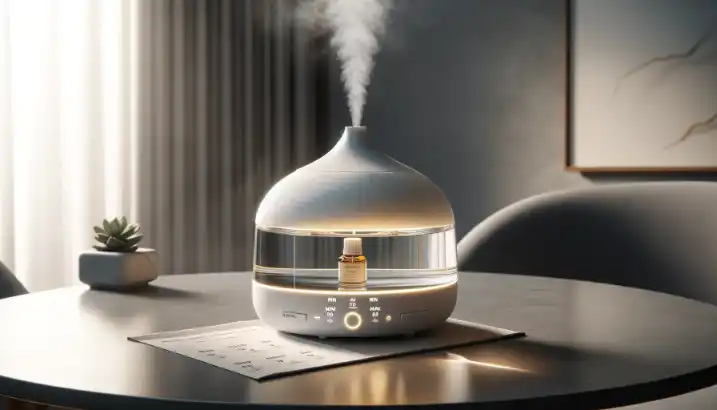Diffuser Not Misting Well? Check These 6 Common Causes
Is your essential oil diffuser not misting properly?
A malfunctioning diffuser can be frustrating when you want to enjoy the aromatic benefits of essential oils. But don’t worry – in most cases, the problem is easy to diagnose and fix yourself.
In this comprehensive guide, we’ll explore the 6 most common reasons your diffuser may not be misting well, along with tips to get it working optimally again. Read on to troubleshoot your diffuser issues!
Water Level Problems
One of the most common reasons a diffuser won’t mist well is an improper water level in the tank. For best misting, the water should be filled to the line specified by the manufacturer – usually slightly below the max fill line.
Too little water can cause the diffuser to not have enough to vibrate and create mist. Overfilling the tank can potentially cause leaks, spills inside the unit, and even damage if water touches electrical components.
To fix water level issues:
- Carefully pour out excess water if overfilled
- Add more water slowly if level is too low
- Use included cup or envelope method to avoid spills
Closely follow your diffuser instructions for the right amount of water. Once the proper level is reached, your diffuser should begin misting normally again.

Mineral and Oil Buildup
Another culprit that can clog a diffuser and impede misting is a buildup of mineral deposits and oil residues. Tap water contains minerals like calcium and magnesium that accumulate over time on parts like the ultrasonic disc. Essential oils also leave behind residue with repeated use.
To remove buildup:
- Soak in equal parts water and apple cider vinegar for 30 minutes
- Gently scrub with a soft brush or Q-tip
- Always use distilled water to prevent mineral deposits
Regular cleaning will prevent clogging issues. J.R. Watkins Natural Cleansing Diffuser Drops can dissolve oils and mineral buildup with natural ingredients.

Bad Diffuser Placement
Where you place your diffuser can also impede its ability to mist properly. Soft surfaces like towels or carpets can absorb the ultrasonic vibrations needed to create mist. Air currents from vents, fans, or air conditioning can also prematurely disperse the mist before it has a chance to diffuse.
To optimize diffusion:
- Place on a hard, flat surface like wood or tile
- Avoid positioning near vents or drafts
- Keep the diffuser lid aligned securely to the base
Proper placement improves airflow and allows the ultrasonic vibrations to form a fine, consistent mist.

Low-Quality Diffuser
Cheap plastic diffusers, especially those made with questionable manufacturing standards, can frequently have misting problems right out of the box. They may not produce enough ultrasonic vibration, have improperly fitted parts, or be prone to breaking.
Investing in a well-made diffuser from a reputable brand can make all the difference in performance and longevity. Consider:
- Durable materials like glass, wood, or thick plastic
- Ultrasonic plate material – ceramic and stainless steel plates last longer
- Warranty and customer service for support
High-end brands like Vitruvi and Airomé are known for quality and consistently good misting.

Wrong Water Temperature
An often overlooked factor is water temperature. Cold water is denser than warm water. The thicker molecular structure makes it harder for ultrasonic vibrations to create micro-fine mist particles.
For best performance:
- Use room temperature, lukewarm or warm water
- Avoid using cold water straight from the tap
- Some models work optimally at specific temperatures
The right water temperature improves diffusion and prevent spitting issues.
Damaged Parts Preventing Misting
If you’ve tried other troubleshooting tips with no improvement in misting, internal damage could be causing the problems. Components like the ultrasonic disc, circuit board, or fan can become damaged over time.
To identify damaged parts:
- Inspect closely for any cracks or malfunctions
- Look for burn marks or detached wires
- Assess noise levels – unusually loud fans can indicate issues
Replacing damaged parts may be necessary for misting to work properly again.
By systematically checking these common issues, you should be able to get your diffuser misting optimally again. Proper maintenance and cleaning will also help prevent many of these problems in the future. Enjoy the wonderful benefits of aromatherapy with a fully-functional diffuser!
Troubleshooting Non-Misting Diffusers
If you’ve checked for all the common issues above and your diffuser still isn’t misting properly, it’s time to dig deeper into troubleshooting. Here are some steps to identify and fix the problem:
Check Power Supply
Make sure your diffuser is getting power. Verify:
- It’s plugged into a working outlet
- The power cord is securely inserted into the device
- You’ve pressed the power button if there is one
- The electrical outlet isn’t connected to a light switch
Restore power fully before further troubleshooting.
Reset the Device
If the diffuser has power but isn’t misting, try resetting it:
- Unplug it from the electrical outlet
- Leave it unplugged for 10-15 minutes
- Plug it back in and check if misting improved
Resetting can resolve electronic glitches preventing mist.
Inspect for Internal Damage
If a reset doesn’t help, carefully inspect the interior:
- Open the housing to access internal parts
- Check the circuit board closely for any signs of burns or damaged wiring
- Assess if the ultrasonic disc is cracked or otherwise compromised
- Make sure the air intake fan spins freely
Repair or replace any visibly damaged parts.
Contact the Manufacturer
For persistent issues, contact the manufacturer, especially if the diffuser is still under warranty. They can provide specific troubleshooting tips or repair options.
Be prepared to answer questions about:
- The age, model number, and purchase date
- What troubleshooting steps you’ve tried
- Any error lights/codes that appear
- The diffuser’s misting history
The company can help diagnose any underlying issues.

With some diligence and patience, you should be able to get even a stubborn diffuser misting like new again. Don’t give up!
Conclusion
A diffuser that isn’t misting well can be infuriating when you want to bask in the aroma of essential oils. Luckily, in most cases, the fix is quite simple once you identify the underlying issue.
Check the water level, mineral buildup, placement, product quality, water temperature, and internal parts to troubleshoot misting problems. Proper cleaning and maintenance will also prevent many clogging and diffusion issues.
With this guide, your diffuser should be dispersing a fine, fragrant mist again in no time. Breathe deep and enjoy the benefits and ambiance of aromatherapy once more!

